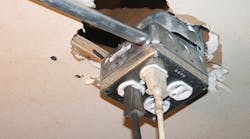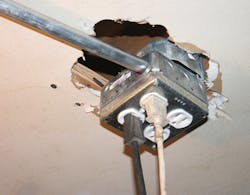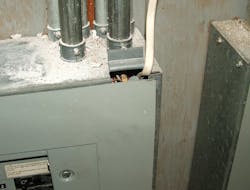Illustrated Code Catastrophes: Sec. 300.21, Sec. 406.5(C), Secs. 312.5(A), and Sec. 110.12(B)
Hack-N-Smash
Apparently, this installer thinks it’s okay to leave a big open hole in the ceiling. There’s no way the sheetrock can be properly patched now that this electrical work has been completed.
Section 300.21 requires us to maintain the fire resistance integrity of fire-resistant-rated ceilings, walls, floors, or partitions. In this case, an installer can meet this requirement by patching up the sheetrock or using some other approved methods. In addition, Sec. 314.21 requires repairing of broken or incomplete non-combustible surfaces around boxes using a flush-type cover or faceplate. Repairs must be made so there is no greater than 1/8-in. gaps or spaces around the box.
The next problem we can point out is the lack of a connector to secure the EMT to the box. Section 300.10 requires metal raceways and metal enclosures to be “metallically joined together.” The raceway must be connected to the box in order to “provide effective electrical continuity.”
Next on the violations “hit list” is Sec. 406.5(C), which states receptacles mounted to and supported by covers must be “held rigidly against the cover by more than one screw,” unless the assembly is listed for use with a single screw.
Overall, this certainly violates the “neat and workmanlike” requirements of 110.12.
Literally Cutting Corners
I can only assume the installer who did this does not own a hole saw or a punch kit — although he sure does have a sharp hacksaw! Cutting and bending away the corner of this panelboard creates several Code violations.
Section 312.5 requires cables and conductors entering enclosures to be protected against abrasion. Those cut metal edges are razor sharp, and could easily cut through the NM cable jacket and conductor insulation.
Section 312.5(A) requires the huge opening to be “adequately closed.” It’s obvious no attempt was made to close the opening. This could easily allow debris to enter the top of the cabinet and cause serious damage to the internal parts.
Section 312.5(C) requires cable wiring methods to be “secured to the cabinet, cutout box, or meter socket enclosure.” That obviously did not happen here.
I would additionally say that 110.12(B) has been violated. The last sentence in this section alerts us to the fact there shall be no damaged parts, including parts that are cut “that may adversely affect safe operation or mechanical strength of the equipment.”
Huge unprotected openings, razor sharp metal edges, and unsecured cables could easily lead to a personal injury or arc-flash event at this location.






